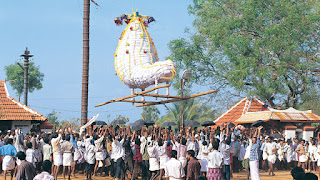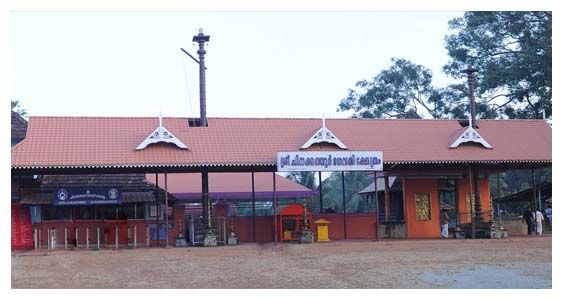The temple is one of the oldest Devi temples in Kerala, situated in Palappuram in Ottapalam Taluk. There are two sancta sanctorum (sreekovil) in the temple which is endowed with the presence of goddess Bhadrakali, namely thazhathe kaavu (lower shrine) and mele kaavu (upper shrine). Traditionally, the pujas in the lower shrine are performed by priests from Namboothiri community whereas those in the upper shrine are performed by priests belonging to Kulangara Nair family.
The temple opens at 5am and closes after the pujas and rituals in the morning around 10.30 am. Normally the rituals include ganapathyhomam, Ushapuja and Uchapuja . The temple reopens for the evening pujas at 5pm. After the deeparadhana and athazhapuja, both the sancta sanctorum will be closed around 8pm.
Palappuram is a small town, located 4 km from Ottapalam, between Palakkad and the Shoranur Highway in Kerala, South Indian noted for the famous Chinakkathur Temple and its festival (known as Chinakkathur pooram) held every year during February/March at the famous Chinakkattoorkkavu Temple of Goddess Durga.
Legend:
There is a myth about the origin of the Chinakkathoor temple which goes back to the Ramayana period. Rama and Lakshmana were wandering in search of Sita when they reached Vilwadri (the Vilwa Mountain). They told lord Ayyappa and Bhagavathy who were accompanying them to find a place to take rest. When they did not return even after a long time, Rama and Lakshmana went looking for them and found them taking rest at the top of the hill. The myth has it that an angry Rama pushed lord Ayyappa down to the south and gave a good beating to Bhagavathy. (The shrine of lord Ayyappa at Vilwadri temple is situated in a lower part from the rest of the structure now- like a pit and the deity is called kundile ayyappan or Ayyappa in the pit!).
Beaten up by Rama, Bhagavathy ran away from there crying “ayyayyo” and stopped running when she reached Chinakkathoor, Palappuram and took position there, facing the north.
The temple faces to the south today. There is a myth regarding this as well.
In the year of 1757, Samoothiri and his army were on their way to attack Paliathachan. When the king and his retinue reached Palappuram, he noticed that the palanquin bearers have stopped moving. When enquired about this, he was informed that there resided the most benevolent Bhagavathy who is sure to hear the prayers of the devotees.
Samoothiri got down from the palanquin, walked to the north and thus asked: “who is it?”, and the Bhagavathy turned to south to face him and replied: “It is Kali.”
Samoothiri duly paid obeisance to Bhagavathy. Since his obstructions were removed, Samoothiri was ready to carry on with his journey. Before leaving the place, he ordered his men to celebrate the annual festival of the temple with all the pomp and glory. He entrusted the landlords to carry out the proceedings of the festival with 16 wooden horses. Kuthirakali - a ritual game of these wooden horses- is performed as part of the festival (pooram) even now.
It is believed that the Bhagavathy in the lower shrine is self-manifested or created by its own accord (swayambu). It is also said that Chinakkathoor temple used to be a place of worship for the people from the lower caste. There is yet another myth which suggests this. Once upon a time, a cheruma girl was cutting grass for her cattle. When she tried to sharpen her knife on a rock, it began to bleed. She was frightened and called up her elders. The older members of the community gathered and felt the presence of Bhagavathy there. They decided to worship Bhagavathy there and tried digging at the sides of the stone to know its depth. But even after digging for a long time, they couldn’t reach the root of the stone. From then onwards, that place came to be known as Chinakkathoor, to mean chinakkiyedutha ooru (the place which was dug out).
Chinakkathoor Pooram:
The pooram at Sree Chinakkathoor Bhagavathy Temple, Palappuram, Palakkad, popularly known as Chinakkathoor Pooram, is one of the major pooram festivals of North Kerala.The Chinakkathoor Pooram is one festival one will not be able to forget for its uniqueness, colourfulness and organic nature with smell of soil and spirit of nature. This Pooram is one which lasts for a full day. In the evening, thirty three caparisoned tuskers march in a grand procession accompanied by percussion ensemble which is typical of temple tradition.
Pooram commences with Koothu and Pooram molayidal function happens ten days prior to the actual pooram. From the time Pooram molayidal happens, People start yelling for help (ayyayyo ayyayyo ) which is there in the myths of Chinakkathoor Pooram. . There's a huge local and global crowd who come here to see the Pooram festival. The pooram is accompanied by Elephants and the traditional Melam. Huge man made Horses (Kuthira) made out of straw, paper and cloth are the special attraction of this festival. It is unique in the sense that nowhere else Poorams has these Horses.
 |
| kuthira kali during festival |
Chinakkathoor pooram is celebrated on Makam Day in the Malayalam month of kumbham which recollection is the vigour and spirit of Mamankam. Valluvanad, the cultural capital of Malabar offers the exquisite beauty of customery arts and Folklores on this occasion in a grand manner. The spectacular procession of 27 caparisoned tuskers with the accompaniment of panchavadyam and pandimelam provide a colourful show to the viewers of Valluvanad. We can see a torrential flow of traditional arts and folklores like Poothan, Thira, Pulikkali, Kumbhamkali, Kudakkali, Theru (chariot), Thattinmelkooth (Dance on the platform) with inexhaustible energy and indomitable enthusiasm to the much acclaimed soil of Chinakkathoor Temple on the same day. The celebration of the above arts provide a footstomping music and influential step which pervade the artistic vision of valluvanad.. The swashbucking performance of pulikkali & Ox Play (kaalakali), ear-breaking sound of para (drum) of Thira & Pootham), Variety of attractive illuminated Panthals, intensive movement of jubilant mob to chinakkathoor neglecting the penetrating heat of kumbham which reveals that nothing else can substitute this festival. On the pooram day, people of Chinakkathoor Thattakam (place) would assemble on the temple ground irrespective of caste and religion to celebrate the festival bidding farewell to their crisis and struggles. Every one would like to participate in the predominant game of Chinakkathoor Pooram.
There are 7 desams (areas) participating in this festival which includes Ottapalam, Pallarmangalam, Palappuram, Erakkottiri, Meetna, South Mangalam & North Mangalam who are striving hard for making the festival a grandeur occasion which shows Keralas rich and vibrant culture.
Chinakkathoor Pooram is a very colorful festival.After the Pooram molayidal Poothan and Thira will visit each and every hindu houses of Valluvanad. Poothan Thira has also got som’e myth behind them.. This is what it says “A typical Poothan Thira performance comprising mostly shouts and wild gestures. The duo is immensely popular amongst the natives and an essential part of the village festivals of the region. Poothan player usually wear in bright (usually red), tightly woven costumes embellished with gold-coloured trinkets. Their larger than life headdresses with peacock features and imposing masks with stick out tongues and eyes are sure to leave an unbelievable imagination to the viewer. Thira player wears semicircular black crown mounted on his head with symbols of the goddess embossed on the same. We can see many Thira players with extra ordinary acrobatic skills who makes the performance a real treat to watch.” Nayadis a particular tribe of people also visit the homes ,singing their tribal songs. One of the song and the lyrics goes like this ….“Naayaadi Naayaadi Chankara Naayaadi” accompanied by the special effects created by hitting two bamboo sticks.
The next custom is Parayeduppu. Velichapaadu who is believed to be the revealer of light, is a mediator between the deity and the devotees. ‘Velichappadu’ literally means ‘the one who throws light on any problems.’ Possessed by the deity, Velichappadu (oracle) dances in frenzy at the festivals in Bhagavati temples. Velichappadu visits each and every house to accept para( which is a vessel used to measure cereals) filled with paddy, Neyyappam, Plantain etc.
The ceremony that comes next is Kuthirakku Thalavekkal. Many huge stuffed horse models are built using bamboo sticks(framework), Plantain leaves(stuffing). Each horse depicts a soldier of army. Once they are done with the body building fixing the head of Kuthirakku Thala Vekkal happens. Valluvanad is divided in to different Desams or villages and all of them have their own troups of this horse armies. On the pooram day people carry this horses to Chinakkathoor Temple and performs the Kuthirakali. This horses compete with each other at the pooram ground. The one who throws or lifts the horse the highest is believed to be the best player. Pooram starts with the horse rally .The Horse rally or Kuthira pooram is followed by the Aanapooram or Tusker Rally. After the kuthirapooram and Aana pooram fireworks happens at the temple ground. Though majority of people leave after the fire works all of them come back to the ground by early morning for the pakalpooram.
The temple now has a website (http://www.chinakkathoorkshethram.in) where it offers online puja booking for its devotees spread across the world. Website also has a wealth of information about the temple.





No comments:
Post a Comment